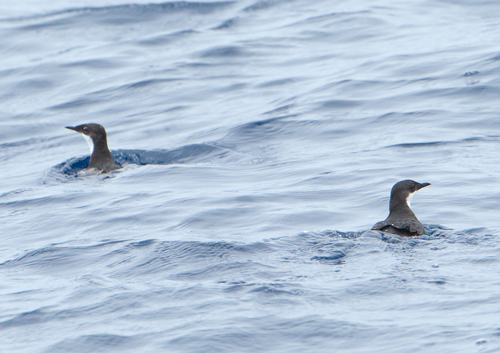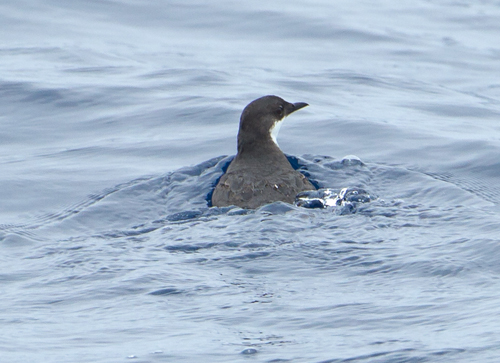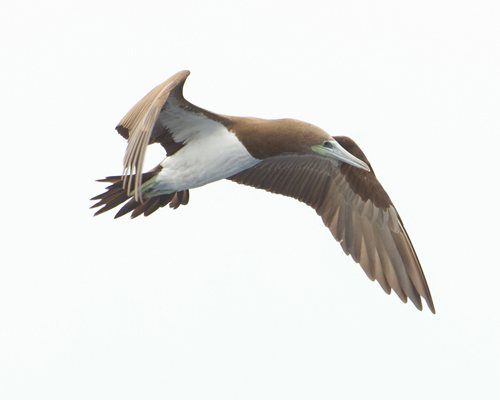Two of the seven ABA Code 2 birds that I have not seen in North America have been the subjects of recent changes of status under the American Ornithological classification system. Nutmeg Mannikins are not native to North America, but have been around in southern California for a long time. Last year they were recognized as a viable population and given recognition by the ABA. At about the same time the species known as Xantus’s Murrelet, was split into two species, Scripp’s Murrelet and Guadaloupe Murrelet. Scripp’s Murrrelet was designated as an ABA Code 2 and Guadaloupe Murrelet was designated as an ABA Code 3. Poor old John Xantus (1825-1894) thereby lost by the stroke of a keyboard one of his only two namesakes in the bird world. I wouldn’t be surprised to see the other one, Xantus’s Hummingbird, succumb to a similar fate if his reputation is not redeemed before that happens.
The Nutmeg Mannikins were easy to find in Tecolote Canyon, on the north side of San Diego. In fact, there must have been at least 30 of them in the flock that flitted about the stream bed near the entrance to the Canyon. I missed them on my way in but Chris, a local birder, figured out what I was looking for and sent me back to the gate area, where I enjoyed watching the noisy flock for a half hour or so. Number 731 on my North American list and leaving 6 on my target class of Code 2 birds.
At 6:30 the next morning I departed from Port Loma on the Grande with a group of about 50 birders, destined to the 30 Mile Bank over a 12 hour excursion. This pelagic outing, sponsored by SOCAL, is an annual event and attracts many local birders as well as a few of us from greater distances. Paul Lehman was the lead guide on the trip and did a fine job of keeping us all informed of not only the birds, but the other natural objects observed along the way. He informed me that to see Scripp’s Murrelets on this trip was far from a sure bet, because most of them had moved out of the area by the end of May. So, it was with great relief and pleasure that about mid-afternoon, 2 Scripp’s Murrelets appeared alongside our boat and gave an unusual opportunity for close-up observation and photography. Many of the folks on the boat were photographers, and one, Doug Galasko, sent me two photos of the Murrelets with permission to use them on this blog.


The Scripp’s Murrelets became number 732 on my North American Life list, and reduced the number of Code 2 birds that I have yet to see to 5. I am hoping to make a clean sweep of the Code 2s within the next year. Three of them will probably mean another trip to Alaska (Whiskered Auklet and Mottled Petrel in the Aleutians and, in Nome in winter, McKay’s Buntings). The other 2, Black Swifts and Sooty Grouse remain a challenge for me but should be found somewhere in the western part of the lower 48.
Doug Galasco also sent me a photo of the somewhat uncommon (in North America) Brown Booby that we saw from the Grande.

The same lady who directed me to the Nutmeg Mannikins in Tecolote Canyon, also suggested that I go to the Bird and Butterfly Garden south of Imperial Beach to see the Black-throated Magpie-jays that have been seen regularly in that vicinity. These are not recognized by the ABA, as there is evidence that they are escapees from pet status and may not have established a viable reproducing wild population here. I was unable to make connections to get back to Iowa on Sunday, the 8th so I drove down to the southwest corner of the United States to look for the Magpie-jays. I missed the turn and drove on to Border Field State Park near Tijuana, Mexico, but on the U.S. side. The gate was closed, but I met a fellow who was planning to hike up to the end of the trail, so we hiked it together. He took my picture by the fence between the U.S. and Mexico.

I walked back to my car and found the Bird and Butterfly Garden where, later in the day, I had the pleasure of observing a flock of 5 or 6 of the Long-tailed Magpie-jays. I took some pictures on my phone, but none of them turned out very well.
